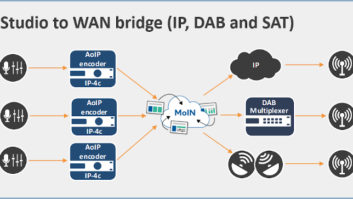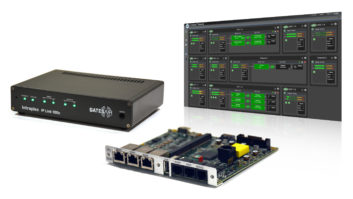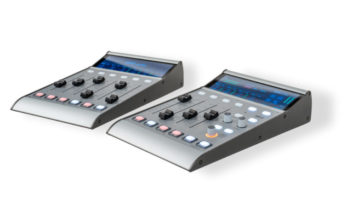IP-based Audio Distribution
Oct 1, 2009 12:00 PM, By Tom Hartnett
Save money by keeping an eye on this changing market
By now it’s pretty well understood that the growth and excitement for moving �broadcast-able� audio from point-to-point (POTS, ISDN, etc.) centers around IP transmission. It’s a good time to take a look at the state of this technology and where it’s headed.
Here in the wired world

A dynamic buddy list on the Access portable display
Good IP codecs now have ultra-low delay coding like AAC-ELD and dynamic buffer managers, so when utilizing an Ethernet connection on a reasonable-bandwidth IP link, these now rival the reliability and delay factors previously experienced with ISDN. This is good because many users are reporting reluctance of telcos to continue to provide and support ISDN, especially for short-term use. And IP of some flavor is now universally easier to obtain than a POTS connection (especially one guaranteed to support a POTS codec). The main pitfalls with wired IP concern fire-walling, dynamic IPs and breaking through commercial login screens.
If you’re connecting an IP codec to a heavily secured network (like at a corporation) there are likely to be ports and protocols blocked. While you can experiment with varying port settings and protocols on your codec, it’s usually safer to work with the IT department to achieve some kind of demilitarization of the connection to your codec.
Commercially available IP connections

Comparison of IP codec stats on different links. Click image to enlarge.
Most publicly available IP connections rely on assigning dynamic or varying IP addresses to computers connected to them. This can complicate incoming connections to codecs. The simplest way around this problem is to be sure the studio IP codec is plainly visible from the Internet (by means of a public, static IP address), and all connections are initiated from the field. In environments where this is not practical, better codecs have a Traversal Server function, which provides some network intelligence in helping make these connections. A Traversal Server subscription (provided by the codec vendor) has the added benefit of providing a dynamic directory of all affiliated codecs that appears on the codec itself much like a buddy list. This way, the user is completely removed from having to know anything about IP addresses on either end of the link, removing the dynamic IP problem as well.
If you’ve ever connected to the Internet at an airport, hotel or coffee shop, you know that they always redirect new users to a login page, regardless of whether the access is free or paid. Many IP codecs connected directly to this type of link have no way of allowing the user to click through this login page. It’s possible to utilize a laptop ahead of the codec to spoof the system into thinking it’s a laptop connection, and using the laptop browser to do the login. But this arrangement is burdensome and complex, so it makes more sense to have a portable IP codec with an integrated browser for these locations. Of course, a codec that easily talks Wi-fi will help here as well.
— continued on page 2
IP-based Audio Distribution
Oct 1, 2009 12:00 PM, By Tom Hartnett
Save money by keeping an eye on this changing market
Caveat emptor
The low price of wired IP connections make them tempting replacements for nailed-up data circuits like DDS, satellite channels and T1s. The best advice I can offer here is that you get what you pay for. Don’t expect a DSL line at $40/month to come with any form of service level agreement (SLA) or guarantee of up-time. But this is certainly being done in environments where the cost of pro links is prohibitive, and the less-than-100-percent reliability factor is acceptable, like feeding transmitters in sparse rural locations. But even users with reasonable budgets can often manage to convert dedicated expensive synchronous links to IP links with some SLA and QoS specified.

Comrex Access (center) with Wimax modem (left) Inmarsat terminal (right) and a variety of 3G and Wi-fi modems (front)
The promise of delivering remotes over 3G wireless services has been realized, but with limitations. In many areas, an IP codec coupled with a 3G data card will get you on-air with remarkable quality and low cost. But in other areas, 3G has become a victim of its own success, with network over-subscription and under-deployment being the main culprits.
Those who deploy a 3G remote system as a replacement for ISDN for long-term programming like sports broadcasts are often disappointed by the network’s ability to be robust for hours at a time. And the ability of specific networks to carry reliable real-time streams (like IP codecs require) varies dramatically even between cities. Figure 2a shows a snapshot of a statistics display using the AT&T wireless network. The top part of the graph shows a 60-second window of time with low network jitter (light blue). In the bottom window, packet loss is indicated by red bars (2a has no red and therefore 0 percent packet loss). Figure 2b shows a connection from the same location using the Verizon wireless network. The red in the graph indicates packet loss, and this connection will exhibit audible drop-outs and artifacts of this loss. To be fair to Verizon, there are other locations where this situation is reversed. Figure 2c shows an even worse connection, this one from a 3G network utilized on a high-speed train, with multi-second intervals of 100 percent packet loss.
Fixing bad wireless
No technology can fix a channel as corrupted as Figure 2c, but there is hope for enhancing the stability of moderately poor channels. Some attempts have been made to apply forward error correction (FEC) or to switch from the snappy-but-fragile UDP transport (favored by real-time Internet devices) to the bulky-but-robust TCP transport. But both of these methods involve dramatically increasing the amount of data sent and received. About the worst thing you can do to a congested channel is switch to a data transport that requires more data, as that usually increases overall congestion and makes the situation worse.
New firmware for Comrex codecs utilizes an intelligent UDP reliability layer called BRUTE (BRIC UDP Transmission Enhancement). Essentially, while data transmission takes place via UDP in the lowest layer, an additional layer checks whether packets have been received and decides whether it’s worth it to request a resend. In addition, this congestion manager has license to reduce codec overhead and step down to modes with lower network utilization dynamically, in essence riding the gain of the data output. Tests show this can allow reasonable operation on networks with moderately high packet loss, without gumming up the works with a lot of overhead data.
— continued on page 3
IP-based Audio Distribution
Oct 1, 2009 12:00 PM, By Tom Hartnett
Save money by keeping an eye on this changing market
4G and other options
A few stations are lucky enough to be located in cities chosen for early deployment of 4G Wimax services, and are having good success on these networks. Wimax offers higher throughput and lower latency and jitter than 3G networks, providing a �wire-like� experience to users. Deployment has slowed during the economic rough patch, but some of the cities on the roadmap for 2009 include Chicago, Dallas and Philadelphia. Verizon is leading the charge with deploying the main 4G competitor to Wimax, called LTE, and plans to have a handful of cities online by the end of 2009.

Andy Denoncour of the Comrex engineering team specs out a 3-mile 5.8GHz IP radio link.
Another attractive network for IP codecs is the Inmarsat BGAN network, which utilizes portable satellite terminals that are ever decreasing in cost and size. The BGAN network also sports a per-minute cost for a codec-capable IP channel that is a fraction of what previous generation satellite networks charged. With BGAN, worries about coverage are non-existent, as long as a reasonable view of the sky in the direction of the nearest satellite is achieved. And the terminals can be set up in minutes by non-technical users.
Some manufacturers have introduced simple, low-cost versions of their IP codecs, and these products mate well with the new breed of inexpensive IP point-to-point radios. Many of these work in the relatively uncongested 5.8GHz unlicensed band, and carry enough bandwidth to provide full-duplex uncompressed audio links. Several brands are available in weather-proof packages with built-in directional antennas and cost less than $500 per end. These make an attractive alternative for cross-city links, or even for extending IP access to non-wired locations.
Migration to IP audio can save money as well as offer new choices in the way audio is shipped for remotes, STLs and other real-time links. As the demand for mobile data increases, so will these choices. It’s wise to keep an eye on this changing market when considering solutions.
Hartnett is technical director of Comrex.












